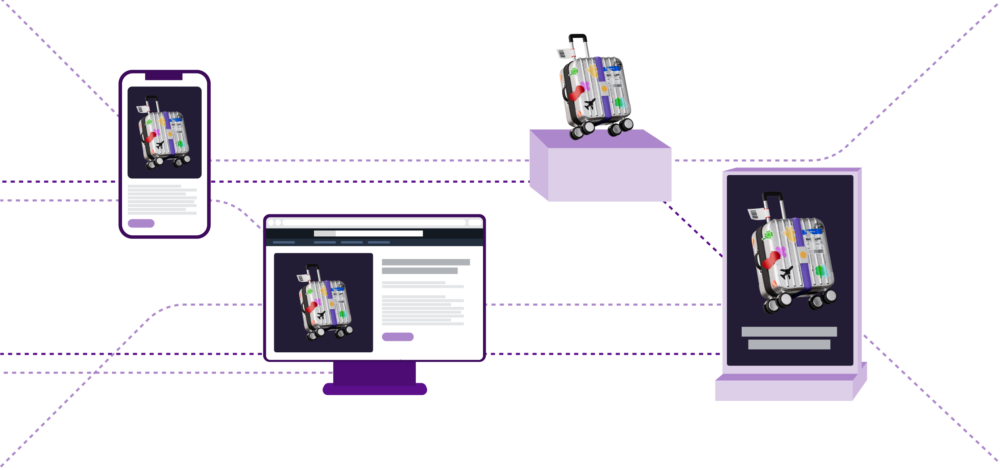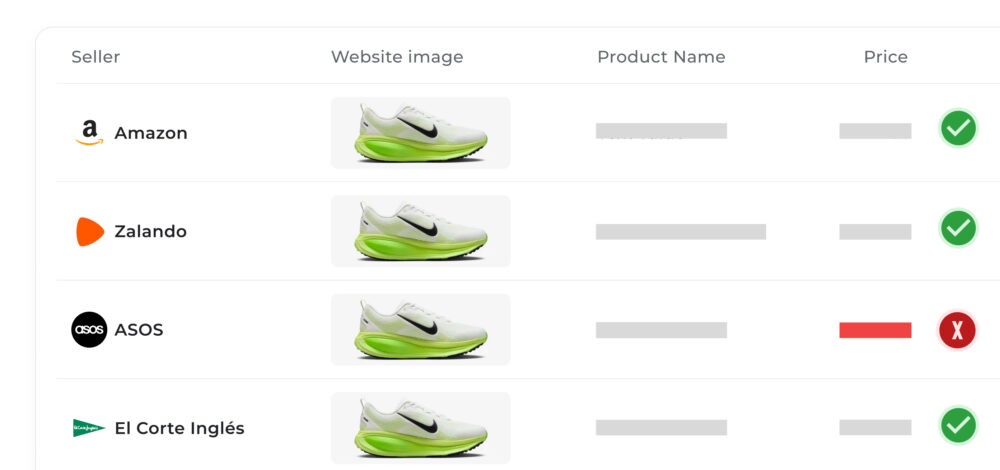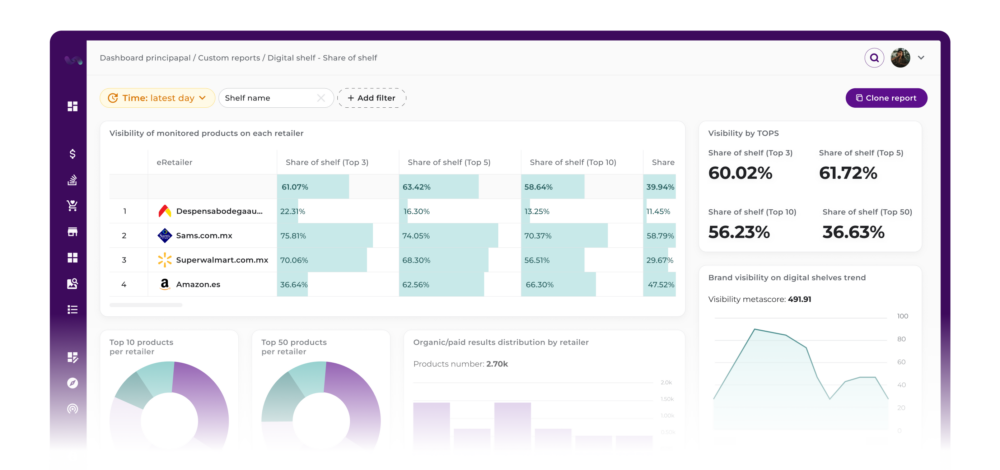True Omnichannel Retailing: Strategies for Synchronising your Digital Shelf Across Marketplaces and Physical Stores
One of the most dangerous cracks in a customer’s trust opens up in the gap between your online store and your physical store. It’s a critical moment that materialises like this: a person finds a fantastic offer for your product on a marketplace like Amazon. Convinced, they go to your store to buy it, but there the price is different, the description doesn’t match, and availability is a mystery. At that very moment, their good experience is ruined. You have just damaged their trust and, almost certainly, lost a customer.
It happens every day, and it’s a disconnect that costs brands dearly. In fact, 71% of customers expect complete consistency when they interact with a company, regardless of whether it’s online or in person. Today, customers don’t distinguish between your online store, your marketplace profile, and your physical store. For them, it’s all one single brand: yours.
The key concept here is the “Digital Shelf”. Think of it as the online version of your physical shelves. It includes everything a customer sees about your product on the internet: photos, videos, the title, descriptions, price, ratings, and availability. When this digital shelf doesn’t match the physical shelf, the customer experience is broken.
This article is a practical guide to avoiding this. We’ll show you the strategies and tools needed to unify these two worlds and build a seamless shopping experience that fosters loyalty and boosts your sales.
Why is Synchronisation a Strategic Necessity, Not a Luxury?
Maintaining consistency across your sales channels goes beyond a simple aesthetic detail. It is fundamental to the growth of your business in today’s environment.
According to a survey conducted by EMARKETER in collaboration with Amazon Ads, a fifth (20%) of shoppers already use a balanced combination of in-store and online shopping.
Let’s look at the main reasons why synchronisation becomes a strategic necessity:
Strengthen trust through brand consistency
A consistent brand isn’t down to luck; it’s down to a system. The title, images, key benefits, ingredient lists or technical specifications must tell the same story wherever the consumer interacts. Consistency builds recognition, reduces friction and strengthens reputation. It also limits misinterpretations arising from outdated product details, truncated content or inaccurate translations. Consistency also protects against distributors who improvise text or use old images. A master catalogue, updated and shared with marketplaces and stores, ensures that the visual and verbal identity remains intact.
Presenting yourself as a consistent brand builds trust, and trust is the foundation of customer loyalty. Every inconsistency, no matter how small, sows a seed of doubt that can lead the customer to look to your competition.
Optimise conversion throughout the customer journey
The modern Customer Journey is complex. A customer might discover your product on a marketplace, research its features on your website, and decide to buy it in your physical store. If they encounter contradictory information at each of these steps, friction is created. A different price, a technical specification that doesn’t match, or a photo that doesn’t correspond to the real product are all obstacles that hinder the purchase decision.
Conversion rates increase when the right information appears at the right time. High-quality photos, how-to videos or size comparisons influence both the online basket and the decision at the shelf. Unifying information eliminates friction and makes it easier for the customer to move forward without hesitation to the final conversion.
Increase the operational efficiency of your teams
Duplicating tasks is a drain on time and budget. E-commerce, trade marketing and retail teams often maintain parallel versions of the same data. Someone creates content for marketplaces. Then, they adapt it for physical stores. And they create something different for their own e-commerce site. This fragmentation leads to errors. For example, the price is updated on one channel, but forgotten on the others.
By centralising and synchronising information, the manual workload is reduced, update cycles are shortened, and the risk of errors is cut. Launches reach all channels at the same time, regulatory changes are reflected without delay, and promotions are scheduled with uniform rules. Operational efficiency not only frees up resources, but it also improves the quality of execution and the speed of response to the market.
Defend and differentiate yourself from the competition
In competitive categories, the first mistake can be costly. An unanswered review, a blurry photo, or a poorly explained price difference are the perfect invitation for a competitor to capture the customer’s purchase intent.
Synchronisation allows you to detect deviations, act quickly, and maintain an advantage on the “shelf” that consumers consult daily: the search results page, the product page, and the physical shelf. Those who control the experience on both fronts can compete more on value and less on price.
The 6 Pillars of Omnichannel Synchronisation
To build a unified customer experience, you need to work on 6 fundamental areas. These are the pillars that will support your synchronisation strategy.
Pillar 1: Product content
Content is the heart of the Digital Shelf. Descriptions, technical specifications, images, videos, and user guides must be identical and of the highest quality across all your channels. A customer shouldn’t find a detailed description on your website and a poor, summarised version on the marketplace.
The problem is that this information is often scattered across different spreadsheets, folders, and systems. The solution is to centralise it. Specialised tools exist for this purpose, such as a PIM (Product Information Management) system. A PIM acts as a central brain for all your product information. From there, you can manage, enrich, and distribute all content to your different channels automatically and without errors. It’s the foundation for ensuring everyone is speaking the same language.
Furthermore, customer FAQs and observations from store staff enrich the content and reduce returns. A workflow with clearly defined responsibilities prevents gaps and ensures a consistent update schedule.
Pillar 2: Price and promotions
Price discrepancies are one of the biggest sources of frustration for customers. Do you have to have the exact same price on all channels? Not necessarily. You can have an exclusive online promotion or a special discount in the physical store. The key is that this difference is a deliberate strategic decision, not an accident due to a lack of control.
You must clearly communicate why these differences exist. Price communicates positioning, and promotions shape the perception of opportunity. To manage this effectively, you need a centralised pricing system. In physical stores, technologies like Electronic Shelf Labels (ESLs) allow you to update the prices of hundreds of products in minutes from a central system, ensuring that promotions are applied instantly and consistently with the online channel, if you choose to do so.
Pillar 3: Stock and availability
Few things disappoint a customer more than seeing a product as “available” online, buying it for in-store collection, and discovering upon arrival that it’s out of stock. This bad experience seriously damages your brand’s image.
Availability must be visible and accurate, both online and in-store. For the digital channel, synchronising inventory, safety stock rules, and replenishment times reduces stockouts and overselling. In physical retail, sharing forecasts with the point of sale and enabling replenishment alerts improves actual on-shelf presence. A click-and-collect option strengthens the bridge between channels. Including store-specific availability information on the online product page guides the customer’s journey and prevents wasted trips.
Pillar 4: Ratings and reviews
Reviews are modern-day word-of-mouth. Collecting, responding to, and systematically redistributing them activates social proof and provides quality insights . Social proof, meaning the opinions of other customers, is a powerful decision-making factor. Traditionally, reviews live in the online world. However, you can bring their power into your physical store to help undecided shoppers.
Imagine a customer in your store, hesitating between two models of headphones. Now, imagine that next to each product there is a small digital screen showing its average 5-star rating and the most helpful comments from other online shoppers. This adds a valuable layer of information at the point of sale. In turn, you can encourage physical store shoppers to leave their opinion online, for example, via a QR code on the receipt, thus enriching the review ecosystem.
Reviews also provide valuable product information. They identify recurring problems and reveal unexpected uses. They also help to improve both the product and its presentation.
Pillar 5: Data governance and compliance
Without data governance, synchronisation degrades. Defining owners for each attribute, review cycles, change traceability, and naming conventions prevents inconsistencies. Regulatory compliance demands rigour: ingredients, warnings, sizes, safety data sheets, allergens or certifications must be validated before publishing. For markets with local requirements, it is advisable to maintain country-certified variants.
Privacy and security also matter: data exchange with marketplaces and retailers under clear contracts, internal access controls, and scheduled backups. A data governance committee, with representation from marketing, legal, operations and sales, ensures continuity.
Pillar 6: Digital Shelf Analytics and enabling technologies
What isn’t measured fades away. Monitoring search result rankings, content coverage, availability, prices, share of search, conversion rate, and review sentiment allows you to prioritise efforts. Proactive alerts detect drops in visibility, unauthorised price changes, or imminent stockouts.
In terms of the technology to achieve this, a platform like flipflow, with our Digital Shelf 360 feature, will help you monitor and optimise your brand’s position and image, making an impact across all sales channels.
Want to know more about this feature? Contact us and speak to an expert about your Digital Shelf.
Practical Guide: How to Start Synchronising your Channels
Understanding the theory is important, but putting it into practice is what generates results. Here are 3 steps to start building your omnichannel ecosystem.
Step 1: Carry out an internal audit
Before investing in any technology, you need to understand where you are. Gather your teams and analyse the current situation. Ask yourself key questions: Do the prices on our website and on Amazon match? Are the product photos the same across all channels? Does our online stock reflect the reality in our stores? How long does it take us to update a product description on all sites?
Identify the biggest points of friction and the most obvious gaps. This diagnosis will allow you to prioritise your efforts.
Step 2: Centralise information with the right technology
As we have seen, technology is a great enabler. A PIM system is essential for centralising product content. Similarly, a DAM (Digital Asset Management) system acts as the guardian of all your digital assets: photos, videos, logos, and documents. And a platform that helps you to monitor your Digital Shelf performance in a unified way, like flipflow, will be the cornerstone for optimising and increasing your brand’s visibility across all channels.
These systems connect to your sales channels via APIs (Application Programming Interfaces), which act as bridges that allow different programs to communicate with each other automatically. Investing in a solid technological foundation will save you problems in the future.
Step 3: Break down organisational silos
Synchronisation is not just a technological challenge; it’s also a cultural one. The best technology will fail if the e-commerce, marketing, and store operations teams work in isolation, each with their own objectives. It is essential to foster collaboration.
Teams must share information and work towards common goals. For example, the success of a “click and collect” strategy depends as much on the online team that promotes it as it does on the store team that prepares the order. A collaborative culture is the engine that drives a true omnichannel strategy.
Conclusion: Building an Ecosystem, Not Just Sales Channels
The customer moves between screens and aisles without thinking about organisational charts. They expect clarity, availability, and a promise that is kept. A Digital Shelf that is synchronised with physical retail organises the narrative, gives coherence to the proposition, and allows for precise competition. The effect is noticeable in conversion metrics, in the workload of the teams, and in the brand’s reputation.
This path requires discipline: auditing rigorously, centralising with technology that serves the business, and coordinating the people who bring the experience to life. The investment pays off for years because it reduces errors, accelerates launches, and strengthens ties with customers and distributors. A well-assembled ecosystem learns from every interaction, responds faster to changes, and turns every touchpoint into a reinforcement of the same story.
The shelf and the algorithm don’t compete. When they are synchronised, they complement each other. The physical shelf benefits from dynamic content, and the digital presence gains credibility thanks to flawless in-store execution. That is the advantage that separates those who survive from those who lead: a brand that is recognised, convinces, and delivers, wherever the consumer decides to buy.











